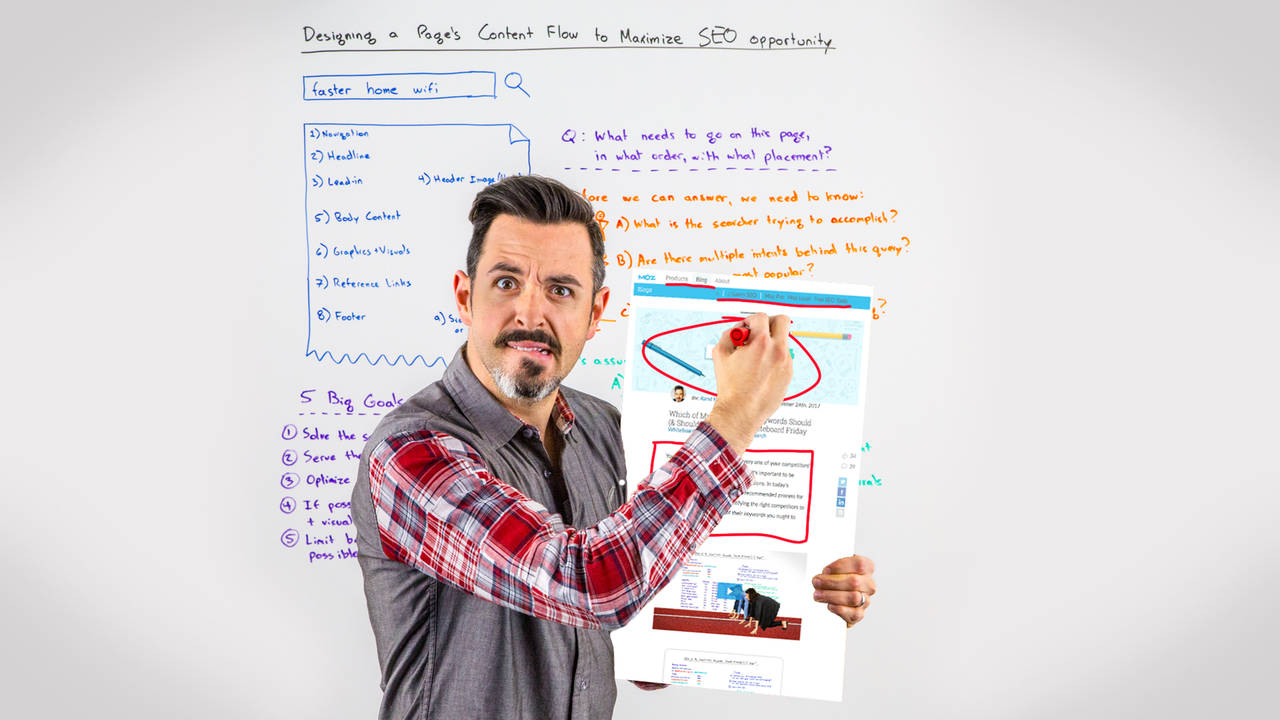Rand covers the questions you need to ask (and answer) and the goals you should strive for in today's Whiteboard Friday. This week we're going to chat about a designing a page's content flow to help with your SEO. I think a lot of people in the SEO world are investing in things like content and solving searchers' problems and getting to the bottom of searcher intent. But unfortunately, the page design and the flow of the elements, the UI elements, the content elements that sit in a page is discarded or left aside. They might be looking for an ISP that can provide them with faster home internet in their area, and they want to know what's available, which is a very different intent than the first one. We now have enough to be able to take care of this design flow. The design flow can involve lots of things. What I see many times is folks will take a powerful visual or a powerful piece of content that's solving the searcher's query and they'll put it in a place on the page where it's hard to access or hard to find. So if we can intuit that most people want to stick with their ISP, but are willing to change equipment, we can serve this one first (B3). In many cases, this means limiting some of the UI or design flow elements that hamper people from solving their problems or that annoy or dissuade them.

Controlling and improving the flow of your on-site content can actually help your SEO. What’s the best way to capitalize on the opportunity present in your page design? Rand covers the questions you need to ask (and answer) and the goals you should strive for in today’s Whiteboard Friday.


Click on the whiteboard image above to open a high-resolution version in a new tab!
Video Transcription
Howdy, Moz fans, and welcome to another edition of Whiteboard Friday. This week we’re going to chat about a designing a page’s content flow to help with your SEO.
Now, unfortunately, somehow in the world of SEO tactics, this one has gotten left by the wayside. I think a lot of people in the SEO world are investing in things like content and solving searchers’ problems and getting to the bottom of searcher intent. But unfortunately, the page design and the flow of the elements, the UI elements, the content elements that sit in a page is discarded or left aside. That’s unfortunate because it can actually make a huge difference to your SEO.
Q: What needs to go on this page, in what order, with what placement?

So if we’re asking ourselves like, “Well, what’s the question here?” Well, it’s what needs to go on this page. I’m trying to rank for “faster home Wi-Fi.” Right now, Lifehacker and a bunch of other people are ranking in these results. It gets a ton of searches. I can drive a lot of revenue for my business if I can rank there. But what needs to go on this page in what order with what placement in order for me to perform the best that I possibly can? It turns out that sometimes great content gets buried in a poor page design and poor page flow. But if we want to answer this question, we actually have to ask some other ones. We need answers to at least these three:
A. What is the searcher in this case trying to accomplish?
When they enter “faster home Wi-Fi,” what’s the task that they want to get done?
B. Are there multiple intents behind this query, and which ones are most popular?
What’s the popularity of those intents in what order? We need to know that so that we can design our flow around the most common ones first and the secondary and tertiary ones next.
C. What’s the business goal of ranking? What are we trying to accomplish?
That’s always going to have to be balanced out with what is the searcher trying to accomplish. Otherwise, in a lot of cases, there’s no point in ranking at all. If we can’t get our goals met, we should just rank for something else where we can.
Let’s assume we’ve got some answers:
Let’s assume that, in this case, we have some good answers to these questions so we can proceed. So pretty simple. If I search for “faster home Wi-Fi,” what I want is usually it’s going to be…
A. Faster download speed at home.
That’s what the searcher is trying to accomplish. But there are multiple intents behind this. Sometimes the searcher is looking to do that..
B1. With their current ISP and their current equipment.
They want to know things they can optimize that don’t cause them to spend money. Can they place their router in different places? Can they change out a cable? Do they need to put it in a different room? Do they need to move their computer? Is the problem something else that’s interfering with their Wi-Fi in their home that they need to turn off? Those kinds of issues.
B2. With a new ISP.
Or can they get a new ISP? They might be looking for an ISP…

COMMENTS